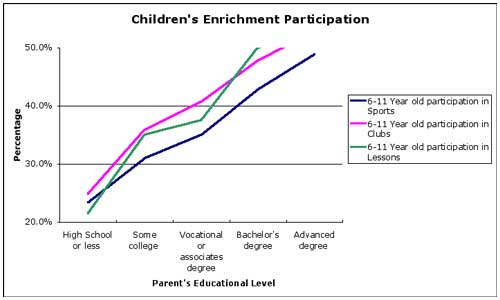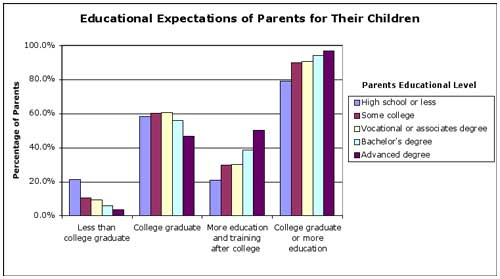
Vol. III, No. 8, September 2003
- From the Editor
- Luxury for the Masses
- Faith Popcorn Defines Today's Kids
- An Educated Society Seeks Enrichment & Edutainment
- Randy White to Present at Fun Expo
- Foundations Entertainment University
- The Challenge of Cost Estimating & Bringing a Project in On Budget
- That's Eatertainment White Paper
- Set Your Opt-In Spam Filters
- New Projects
An Educated Society Seeks Enrichment & Edutainment
Data from the 2000 US Census shows how America is continuing to become an increasingly educated society. According to the Census, for people aged 25 and over, 80% had a high school diploma and 24% had completed at least a bachelor's degree. Compared to 1990, the proportion of people with a high school diploma has increased 7% and the number with at least a bachelor's degree has increased 20%. Going back to 1940, the proportion of the adult population that graduated from high school has more than tripled, and the number with a bachelor's degree or higher is more than five times greater.
What segment of the population is the most educated? Asians hold bachelor's and advanced degrees at a rate almost twice that of the overall population. For regions of the country, the Northeast has the highest percentage of bachelor's degrees and advanced degrees. High percentages of college graduates are found in suburban areas around metropolitan areas and in college towns. The states with the highest levels of bachelor's degrees or higher are Colorado, Connecticut, Maryland, Massachusetts, plus the District of Columbia. And for cities of 100,000 or more population, Cambridge, MA; Ann Arbor, MI; and Berkeley, CA, have the highest percentages of people with doctoral degrees -- eight times or more than the national average.
Educated consumers control the majority of expendable entertainment dollars, as there is a direct relationship between education levels, income and entertainment spending. In 2001, on average in the US, households headed by high school graduates earned $37,800 and spent $276 on out-of-home entertainment fees and admissions. Bachelor's degreed households earned $70,100 and spent $993 on the same type of entertainment. Master's or professional degreed households earned $86,700 and spent $1,229.
In aggregate, households headed by non-college graduates (65% of all households) spent $21.2 billion on out-of-home entertainment in 2001, whereas associate or higher college degreed households (35% of all households) spent over three times as much per household for a total of $36.8 billion. In other words, college degreed households make up slightly more than one-third of all households, but are responsible for about two-thirds of total out-of-home entertainment expenditures. It doesn't take a brain surgeon to see where the entertainment market's potential is and what market niche to chase.
What does an educated society mean to location-based entertainment (LBE), besides knowing what socio-economic group holds the greatest revenue potential? It means that a large segment of the potential market of guests value knowledge and enrichment. For example, The 1999 National Adult Education Participation Report by the National Center for Education Statistics found that 23% of all adults took one or more college courses strictly for personal enrichment, for non-work related, personal development purposes. This increased desire for life-long learning and self-improvement has created a new entertainment trend. Now, instead of just wanting purposeless or mindless relaxation and entertainment, a large percentage of people want to use their highly valued leisure time not just for a respite, but also as an opportunity to improve themselves and their children.
At least for college-educated households, entertainment that includes an educational element is more valued than mindless amusement. This trend has led to the increased popularity of museums, zoos, aquariums, botanical gardens, historic attractions and other cultural institutions, some of which are now for-profit businesses.
The trend is also fueling the growth of for-profit edutainment facilities, including children's edutainment centers. Parents today are especially eager to expose their children to enriching experiences and every possible opportunity for improving achievement. In many cases, this is resulting in children being over-scheduled with organized activities. Child magazine, in its August issue, offered an explanation for this trend: "We're also a nation of workaholics, so it's not surprising that we're passing our super-sized work ethic on to our children in the form of organized activities." The magazine went on to say, "Parents' urge to sign children up for enrichment activities may also reflect a generational trend, as more Gen X parents try to give their kids what they wish they'd had in childhood." This trend is validated by research by the University of Michigan Institute for Social Research that found that during the past 20 years, children's unstructured free time has declined from about 40% of the average child's day to 25% today. There's even a book on this phenomenon, The Over-Scheduled Child, by Dr. Alvin Rosenfeld.
A backlash is starting to occur from this over-scheduling of children's lives. As Faith Popcorn captures with her terms clean time and free-range children, discussed in the preceding article, some parents are saying enough is enough. Most child development experts agree that before grade school, children don't need structured extracurricular activities, and even in early grade school, one or two activities are enough. David Elkind, Ph.D., at Tufts University, one of the country's leading child development experts, says this about structured activities: "There's no evidence they help your child succeed in life."
What's more, there can be many detrimental effects of introducing children too early and too often to extracurricular activities, including children being overwhelmed socially, children developing an aversion for the activity by not being developmentally ready to handle it, and possibly damaging the child-parent relationship. Dr. Brad Sachs, Ph.D., a family psychologist, says, "When a child is forced into doing something she's not ready for, the parents tend to feel disappointed and the child feels she's letting the parents down." The biggest complaint most experts have with structured programs and over-scheduled children is that it robs children of time for unstructured free play and a chance to just wonder and use their imaginations -- essential requirements for children's development of both creativity and their intellectual abilities. For healthy development, young children need free play time, and lots of it.
There is strong evidence that parents with the most education have the highest interest in seeing their children attend enriching programs. Data from the Census Bureau's Survey of Income and Program Participation looks at the well-being of children and their daily activities. Data collected between 1996 and 2000 found that for families composed of parents with a high school degree or less education, only 24% of their children between 6 and 11 years participated in extracurricular sports, 25% in extracurricular clubs and 22% in extracurricular lessons. When parents had a bachelor's degree, the children's participation in these activities increased to 43%, 48% and 50%, respectively, about double the rate. The participation for advance-degreed parent families was even higher at 49%, 53% and 55%. When parents were asked if they wanted their child to have more education and training after college, 21% with high school or less education answered yes, 38% with a bachelor's degree answered yes and 50% with advanced degrees answered yes.

Prents Parents with advanced degrees were 2.5 times as likely as parents with a high school education or less to want their children to get an education beyond college. Interestingly, when the data is combined for parents who want their children to have a college degree or want their children to have more education after college, there is less disparity based on the parents' education level — 79% with a high school education or less versus 97% with advanced degrees.

Children's edutainment centers (CEdCs) meet the desires of parents who feel obligated to offer their children extracurricular activities, including playgroups and classes, as well as parents wanting to give children free play or clean time. The majority of events and activities in CEdCs are based on unstructured play, where children are empowered and in charge. The scheduled activities, such as enrichment workshops, are based on the principal of developmentally appropriate practice and designed as fun for children, not as teacher-directed structured learning. Although many parents want to offer their children more free play time, especially outdoors, many are paranoid about letting their children play even in their own backyards for fear of abduction. Marc Francis, a professor of landscape architecture at University of California-Davis, has termed this phenomenon as the childhood of imprisonment.
Well-designed and managed CEdCs offer an extremely secure environment where parents can feel safe that their children will never leave with anyone else. That factor, plus well-trained play facilitators who monitor children's play to assure safety, allow parents to relax and socialize with their friends. Children also have the opportunity to develop socialization skills with other children, or, if they're not ready for that or are shy, they can play alone. And the inclusion of an outdoor adventure play garden offers children outdoor play and a chance to connect with nature, something often missing, but much needed in children's lives. CEdCs also can be expanded in scope to include a dedicated children's enrichment center that provides a more extensive offering of enrichment workshops.
Our company believes that to be successful long term with families in today's out-of-home leisure market, LBLs need to include edutainment and enrichment content. That is why our company pioneered the concept of children's edutainment centers and children's enrichment centers and is now developing a concept we call family lifestyle centers that further broadens the educational and enrichment offerings.
For additional discussion of this subject, see our white paper, That's Edutainment!
Vol. III, No. 8, September 2003
- From the Editor
- Luxury for the Masses
- Faith Popcorn Defines Today's Kids
- An Educated Society Seeks Enrichment & Edutainment
- Randy White to Present at Fun Expo
- Foundations Entertainment University
- The Challenge of Cost Estimating & Bringing a Project in On Budget
- That's Eatertainment White Paper
- Set Your Opt-In Spam Filters
- New Projects


